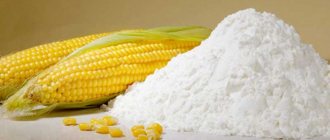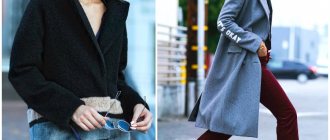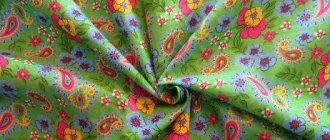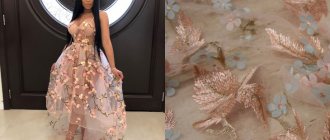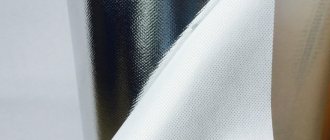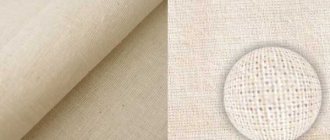Lederin
Lederin is a cotton fabric - calico - on the back side of which a layer of starchy primer is applied, and on the front side there is an elastic film of nitrocellulose, a plasticizer (castor oil), pigments and fillers. A relief pattern is applied to the surface of the lederin using an embossing calender.
Lederine resembles natural leather in appearance and water resistance. It does not change its appearance and does not lose its embossing relief when applied with glue. There may be 10 mm unprimed edges left on both sides of the lederin sheet.
Lederin has the following properties:
- a flat and smooth surface with relief embossing, for example, reminiscent of the texture of natural leather (morocco, shagreen);
- warp hardness 6-12 and weft 4-9 g;
- non-sticky elastic nitrocellulose film is firmly connected to the base fabric and does not crack when bent;
- there is no migration of dyes on the surface of the film, leading to a change in the shade of the material;
- light fastness and heat resistance.
Lederin is also characterized by increased elasticity, so when making binding covers it is necessary to use very sticky binding glue, such as bone glue. The plasticizer, castor oil, significantly reduces the drying rate of binding inks when printing on binding covers. In the process of printing with binding inks or when foil stamping, lederin, due to its high elasticity and deep embossing relief, requires the use of high pressure. When embossing, the colored binding foil is loosely attached to the surface of the lederin. A significant disadvantage of lederin is its high cost, which is associated with the use of expensive organic solvents in the process of its production. In addition, the toxicity of these solvents worsens working conditions.
When making lederin, not fabric can be used as a base, but especially strong cable paper made from unbleached sulphate pulp. Lederin on paper is additionally coated with nitrocellulose varnish, which increases its mechanical strength and protects the bindings from sticking together.
In appearance, leatherette on paper is no different from fabric, but is significantly inferior to it in strength, especially when bent and torn. The adhesion strength of the nitrocellulose film to the base of paper lederin is also significantly lower than that of fabric. In addition, ice cream on paper, if it does not have a deep enough embossing relief, can curl strongly when applied with glue. The main advantage of paper lederin compared to fabric is its low cost.
Paper lederin is used for the manufacture of composite bindings with a fabric spine, as well as in the production of white goods.
Due to the greater smoothness and lower absorbency of the base paper compared to fabric, it is enough to apply two layers of nitrocellulose primer weighing 50 g/m2 to the front side of the paper lederin. On the glossy surface of the lederin paper, you can perform any textured embossing, blind embossing, stamping with colorful and bronze foil, and in addition, you can print with bookbinding inks.
Paper lederin is available in rolls. Its tensile strength is at least 7 kg, its breaking strength (number of double bends) is at least 300. When folding the lederin, cracks should not appear on the paper.
Latex coated binding materials
Technical fabrics with latex coating are plain fabric or paper, on the back side of which a starchy primer is applied, and on the front side there is a film consisting of latex (a copolymer of vinyl chloride with vinylidene chloride), starch, pigments and fillers (kaolin, lithopone).
The polymer film is applied to the front side of the fabric by double priming using a cylindrical primer-drying device. Smoothing of the primed fabric is carried out by a friction calender; embossing the pattern using an embossing calender.
Latex-coated binding material has the following advantages over lederin:
- high quality surface finish (can be glossy or matte, but lederine is produced only glossy);
- great strength;
- elasticity.
Latex-coated paper-based bookbinding materials are the best substitutes for fabric lederin. They have a very impressive appearance and satisfactory mechanical properties, especially against abrasion, since the latex primer impregnates the paper and makes it more durable.
What kind of fabric
The calico material is known primarily to printing house workers; book bindings and covers are made from it. Calico binding is a dense cotton fabric that has undergone special treatment, which makes it rigid and resistant to friction and bending.
Calico got its name from the word calencar (French), which means “chintz from Calcutta.” The expression came to the French language from the east - kalamkar - this is what the Persians called the dyed gray fabric.
According to one version, the material began to be produced in India. After it came to Europe, the technology was modernized and the fabric became more widely used.
According to another, dense and rigid textiles began to be produced in weaving factories in Great Britain in 1825. The fabric was also known in our country. In the work of the Soviet writer A. Yugov one can find the following lines: “the pockets were double: the inner one was made of linen, the outer one was made of gray calico.”
The material was actively used in the production of books for the manufacture of covers and bindings. In the 19th – early 20th centuries, fabric had wider use. Curtains, shirts, and bed linen were made from bleached starch fabric. Used for finishing belts, pockets, and bottoms of clothes. Archival folders with calico have been and are being released.
What is calico?
Almond blossom
Calico, according to some sources, is glued and dyed calico - a harsh thin cotton fabric of plain weave, quite thick threads of unbleached yarn are visible, used for sewing cheap linen clothes, calico as a lining. borrowed
Calico fabric (see figure), when impregnated with sizing, was used in printing for the manufacture of covers, gift boxes, cases, and book bindings.
Sometimes they say “a completely different calico” - this stable expression is used in the meaning of “not what is needed” or “something else”, apparently because there is a great variety of calico in the meaning of dyed fabric, and possibly because when impregnated the same tissue becomes heterogeneous.
Rakitin Sergey
The basis of many cotton fabrics is calico - a simple undyed cotton fabric. Outwardly, it is unattractive, rough to the touch, but it is very cheap. By impregnating calico with starch, calico was obtained - a rigid, slightly bendable fabric fabric (white or plain), which was used where it was important to maintain shape - for the manufacture of clothing linings and in the production of book bindings. The latter were subjected to further finishing, i.e. applying compositions in the form of varnishes and mastics, which turned cheap fabric into luxurious book binding (hence the expression “another calico”).
Grape marmalade
Calico originally called Indian or Persian (that is, Iranian) cotton fabric used for book binding and strengthening the inner layers of clothing.
Calico was in vogue in the 18th and 19th centuries; the spread of more modern fabrics led to its abandonment.
Also called calico was a specialized binding material (made from the appropriate fabric).
And finally, for some reason a third meaning has become entrenched in everyday life (the expression “a completely different calico”, meaning literally “not the same at all”).
bolshoyvopros.ru
Binding calico
Binding calico is a cotton fabric, dyed or undyed, calico, on both sides of which a film of starchy substances, mineral fillers and organic dyes is applied.
When making bookbinding calico, the base fabric (calico) is dyed in the color of the ground with direct (acid) dyes, dried and smoothed. Then a layer of soil weighing 20 g/m2 (based on dry residue), consisting mainly of starch, casein, kaolin and water, is applied to the back side of the calico. The front side of the binding calico is subjected to single or double priming on a priming-drying device. For this, the same primer is used as for priming the reverse side, but with the addition of 0.5-1% dyes. The calico is subjected to double smoothing on a friction calender and embossing of the pattern using an embossing calender.
Binding calico, as a rule, is produced in two types: KP - weighing 170 ± 15 g/m2 (for the manufacture of binding covers) and lightweight KF - weighing 135 ± 5 g (for folds).
The quality of binding calico must meet the following requirements:
- twisting of the binding calico when it is moistened on one side must reach the established limit in a time of at least 10 s;
- when bending, there should be no cracks on the surface of the calico;
- high stability of embossing and calico color when gluing it to cardboard;
- A slight change in the color of the samples is allowed after prolonged exposure to sunlight;
- dry friction strength of at least 4 points (on a five-point scale);
- the force that causes a decrease in the deflection of a sample measuring 10 x 95 mm, fixed in the form of a sphere in a special clamp, by one third (from 30 to 20 mm), should be 9-21 g for the warp, and 6-18 g for the weft.
Binding calico is characterized by a matte surface, a variety of colors and textures, and manufacturability for foil stamping and printing with bookbinding inks. The main disadvantages of bookbinding calico:
- insufficient water resistance of the starch film, as a result of which the material may lose its original attractive appearance;
- soiling;
- relatively rapid aging and shedding of the starch film;
- the possibility of soaking through glue when making binding covers;
- the starch film does not completely hide the texture and defects of the fabric, which affects the appearance of the binding calico;
- under unfavorable storage conditions, bookbinding calico becomes moldy.
Bookbinding calico "modern"
Calico "modern" is a binding material that retains the texture and color of the base fabric - bleached or gray calico, dyed with organic dyes. Using a cylindrical primer-drying device, a white starchy primer is applied to the “modern” on the back side and a transparent colorless primer on the front. Then the primed (finished) calico is passed through a friction calender twice, and sometimes varnished with ten percent nitrocellulose varnish (see below).
Binding calico with nitrocellulose finish
Ten percent nitrocellulose varnish, when applied to calico binding, is partially absorbed into the thickness of the material, increasing the adhesion of the starch film to the base fabric, and partially remains on the surface, improving the appearance of the fabric and protecting it from the effects of water. However, varnished calico can be sticky, which often leads to bindings and varnished dust jackets sticking together if books with the same binding are placed next to each other on a shelf.
Strengths and weaknesses of the material
Unlike textile models, high-quality calico must meet the following requirements:
- Once wet it curls easily. It is not necessary to completely soak in liquid. It is enough to wet one of the sides;
- strength. Resistance to mechanical damage is tested by friction and bending. After deformation, the canvas should not form creases or cracks;
- preservation of the original structure and color after gluing;
- invulnerability to direct sunlight.
For information! Users highlighted the variety of textures, shades and embossing among the positive features.
Among the shortcomings are:
- poor moisture permeability. The accumulation of liquid on the surface leads to the destruction of the starch component. Possible shedding;
- accumulates dirt. The absence of special impurities that repel dirt, the surface becomes a “magnet” for dust and various kinds of stains;
- deformation during gluing process. The original shape is distorted after applying the solution;
- vulnerable to mold formation. Violation of storage conditions leads to the formation of harmful “spraying”. This leads to spoilage and premature aging.
Important! For a product to have value, it is necessary to carefully approach the issue of care to increase its service life.
Where is calico material used?
Since this material is very durable, does not wrinkle or fade, it is often used to protect windows. That is, for sewing curtains that can be painted in any color.
Moreover, many years ago such a phenomenon as calico binding was known. It could be seen on books, in particular on rare editions. Now the material is also used to create souvenir boxes and cases.
Some artists may often use canvas in the form of canvas, since such material is inexpensive and its properties allow it to be used for such purposes.
Some types are technical fabric. It is also used:
- Used for restoration;
- Strengthen diagrams or geographical maps with it;
- They make “strips” for folders, diaries, notebooks;
- Bindings,
- Gift boxes;
- Printing a reproduction or photograph;
- Artists use it as a canvas;
Find out everything about moleskin material in our other article.
Storage
It is important that when using calico binding material in one of the above types, the optimal temperature in the room is maintained. This is necessary in order to protect it from mold. If you follow these simple requirements, then things will remain in perfect appearance for a long time, and when you pick up a bound book, you will not be able to tear yourself away from it. Be sure to look at how to remove a red wine stain in our article at the link.
